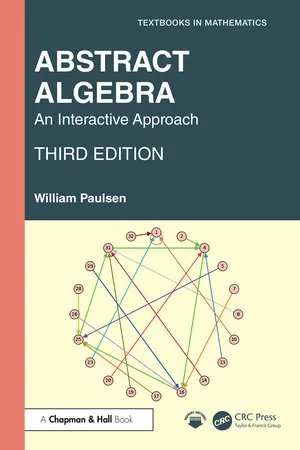
- 556 pages
- English
- ePUB (mobile friendly)
- Available on iOS & Android
About this book
Abstract Algebra: An Interactive Approach, Third Edition is a new concept in learning modern algebra. Although all the expected topics are covered thoroughly and in the most popular order, the text offers much flexibility. Perhaps more significantly, the book gives professors and students the option of including technology in their courses. Each chapter in the textbook has a corresponding interactive Mathematica notebook and an interactive SageMath workbook that can be used in either the classroom or outside the classroom.
Students will be able to visualize the important abstract concepts, such as groups and rings (by displaying multiplication tables), homomorphisms (by showing a line graph between two groups), and permutations. This, in turn, allows the students to learn these difficult concepts much more quickly and obtain a firmer grasp than with a traditional textbook. Thus, the colorful diagrams produced by Mathematica give added value to the students.
Teachers can run the Mathematica or SageMath notebooks in the classroom in order to have their students visualize the dynamics of groups and rings. Students have the option of running the notebooks at home, and experiment with different groups or rings. Some of the exercises require technology, but most are of the standard type with various difficulty levels.
The third edition is meant to be used in an undergraduate, single-semester course, reducing the breadth of coverage, size, and cost of the previous editions. Additional changes include:
- Binary operators are now in an independent section.
- The extended Euclidean algorithm is included.
- Many more homework problems are added to some sections.
- Mathematical induction is moved to Section 1.2.
Despite the emphasis on additional software, the text is not short on rigor. All of the classical proofs are included, although some of the harder proofs can be shortened by using technology.
Frequently asked questions
- Essential is ideal for learners and professionals who enjoy exploring a wide range of subjects. Access the Essential Library with 800,000+ trusted titles and best-sellers across business, personal growth, and the humanities. Includes unlimited reading time and Standard Read Aloud voice.
- Complete: Perfect for advanced learners and researchers needing full, unrestricted access. Unlock 1.4M+ books across hundreds of subjects, including academic and specialized titles. The Complete Plan also includes advanced features like Premium Read Aloud and Research Assistant.
Please note we cannot support devices running on iOS 13 and Android 7 or earlier. Learn more about using the app.
Information
Table of contents
- Cover Page
- Half-Title Page
- Series Page
- Title Page
- Copyright Page
- Contents
- List of Figures
- List of Tables
- Preface for Students
- Preface for Instructors
- Acknowledgments
- About the Author
- Symbol Description
- Installing the Notebooks
- 1 Preliminaries
- 2 Understanding the Group Concept
- 3 The Structure within a Group
- 4 Patterns within the Cosets of Groups
- 5 Mappings between Groups
- 6 Permutation Groups
- 7 Building Larger Groups from Smaller Groups
- 8 The Search for Normal Subgroups
- 9 Introduction to Rings
- 10 The Structure within Rings
- 11 Integral Domains and Fields
- Answers to Odd-Numbered Problems
- Bibliography
- Index